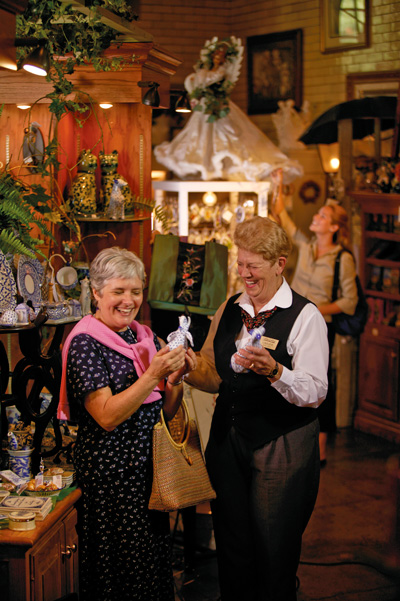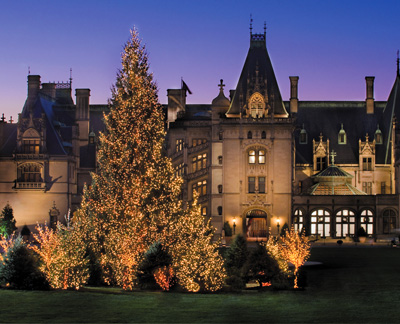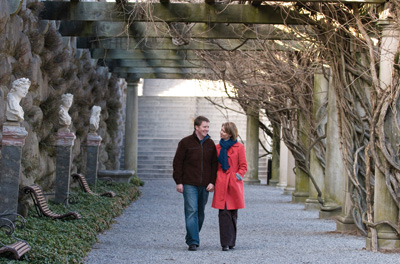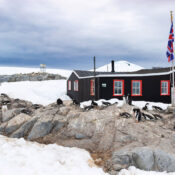This time of year, Biltmore is ablaze with holiday decorations, the front lawn covered with sparkling evergreens and softly lit tulip poplars, its centerpiece a tall Christmas tree trimmed with twinkling stars. A fantasy-like scene, perfectly suited to this evening’s program, “Candlelight Christmas Evenings,” an annual holiday celebration that extends from November 6 to January 3.
It seems appropriate: Christmas candles have been glowing here every season since 1895, when Vanderbilt first occupied Biltmore House two months before the holidays, and on Christmas Eve held a festive party with gentlemen guests dressed in white tie and tails, ladies in full-length ball gowns.
While I’d visited the estate as a teenager and again as an adult, my wife had never been. Walking toward the house, our tracks trailed behind us in the snow. In the twilight, the surrounding landscape hinted of vast forests and distant rivers — 8,000 acres in all. The estate includes River Bend Farm with an assortment of goats, chickens, and horses roaming freely in the barnyard; an award-winning winery; a deer park; a river for rafting; winding drives; and the 213-room four-star Inn on Biltmore Estate.

Photo courtesy of The Biltmore Company
As a young man of 25, Vanderbilt chose this locale in the Blue Ridge Mountains in Asheville, North Carolina, following a visit with his mother. His original purchase was 125,000 acres, a parcel three times the size of the District of Columbia. The mansion took him some six years to build.
At the entrance to the property lies a Tudor village, built to house the workers who constructed Biltmore House. Today Biltmore Village is a trendy district offering chic boutiques, sidewalk cafes, and antique shops. The house itself opened to the public for the first time in 1930. Today, 1,800 employees attend to the estate’s upkeep. As we strolled toward the house, I took in its magnificent stone architecture, a French Renaissance chateau design by Richard Morris Hunt. Topped with hunched gargoyles and a steeply pitched roof, it looks as impressive now as it did in movies such as The Swan with Grace Kelly and Being There with Peter Sellers. Biltmore House has six levels: four floors plus a basement and sub-basement. The Banquet Hall rises 70 feet high.
The mammoth entrance is manned by ticket takers, for today Biltmore House is a commercial enterprise that welcomes more than 1 million visitors a year. Docents hand out earphones for an audio tour hosted by Bill Cecil, Vanderbilt’s great-grandson. The family still owns the property, with Cecil serving as president and CEO.
Just off of the Entrance Hall, the tour begins in the Winter Garden Room, a glass-ceiling solarium that, tonight, is festooned with lights. Ballroom dancers in period costumes twirl around the circular room, a festive touch for the season. Making our way to the vast Banquet Hall, we encountered the pièce de résistance, a 35-foot Christmas tree that lords over the room, pointing toward the seven-story-tall ceiling, next to the twin chandeliers and a magnificent pipe organ that is playing carols. Each November, two big Clydesdale horses pull an enormous Fraser fir to the house, taking it into the Entrance Hall and around the Winter Garden, past carved friezes of Greeks on horseback, before squeezing into the portal to the Banquet Hall. The massive stone pillars here bear the scrapings of branches being pulled through year after year.
From here we explore a Tapestry Room and book-lined Library, decorated with treasures from around the world, including Napoleon’s personal chess set, just in front of the giant stone fireplace. More than 10,000 volumes in eight languages attest to a contemporary newspaper’s claim that Vanderbilt was “the best read man in the country.”

Photo courtesy of The Biltmore Company
Upstairs visitors will find 33 bedrooms, sitting rooms, and guest quarters, as well as four never-before-seen rooms to explore. In a newly opened Louis XV Suite, we found a feather tree with tabletop trees in crystal and gold and heavy garlands surrounded the fireplaces.
Floral display manager Cathy Barnhardt and her staff work all year planning the holiday event. Every room is decorated as if awaiting holiday guests. Outside, to the left of the House, there are several gardens and a Conservatory.
Later we enjoyed a Christmas dinner at the Stable Café, one of five restaurants and grills on the property. As the name suggests, this one occupies the old stable building. Its surroundings have been transformed into a shopping experience offering an array of small stores.
The Carriage House Shop features teapots and lamps and jewelry and Biltmore-brand salad dressings — not to mention wines bottled on the estate.
A confectionery shop offers mountain taffy, French chews, white chocolate champagne balls, and milk chocolate cherry cordials.
I lingered in the tiny Toymaker’s Shop, a cornucopia of teddy bears, rocking horses, and monkeys on a swing. In addition to the stuffed animals, storybooks, and iron blacksmith’s puzzles, there were turn-of-the-century Biltmore dolls, eye-dazzling kaleidoscopes, and hand-carved spinning tops.
There’s even a shop called A Christmas Past that sells holiday decorations: Father Christmases, Nativities, angels, and toy soldiers. Poinsettias, wreaths, and fat snowmen surround the room, imbuing it with a genuine sense of holiday cheer.

Photo courtesy of The Biltmore Company
As we took the shuttle back to the parking area, driving the winding roads through the snow-covered night toward the stone archway that marks the entrance (and exit) to the Biltmore Estate, I couldn’t help thinking about the live reading we’d heard on the third floor earlier that evening, the story of “The Little Match Girl.” Her tiny flames were nothing compared to the candles flickering throughout the mighty mansion; her poverty a contrast to the lavish lifestyle on display. But the last line of the story came to mind: “No one imagined what beautiful things she had seen, and how happily she had gone … into the bright New Year.”
We enjoyed our visit and saw many beautiful things. A visit to Biltmore House during the Christmas season is a journey into the extravagant past, a time when moneyed families led a palatial existence. And today you can share that grandeur. At least for one candlelit, snowy night.
Become a Saturday Evening Post member and enjoy unlimited access. Subscribe now




Comments
It would take a Vanderbilt to pay the heating bill.